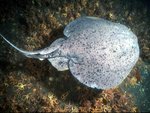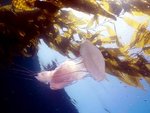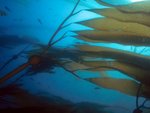Channel Islands National Marine Sanctuary
Contents
Introduction Map of the Channel Islands. (Source: National Marine Sanctuaries (Channel Islands National Marine Sanctuary) )
The Channel Islands National Marine Sanctuary (CINMS) was designated on September 22, 1980 in part to protect "significant cultural, natural resources." Administered by the National Oceanic and Atmospheric Administration (NOAA) as part of the The National Marine Sanctuary System, the 1,252.5 square nautical mile sanctuary encompasses the waters surrounding the northern channel islands (Anacapa, Santa Cruz, Santa Rosa, San Miguel) and Santa Barbara Island from high tide to six nautical miles offshore. The CINMS completely surrounds the Channel Islands National Park. The sanctuary includes the entire three miles of California state waters plus an equal distance of Federal waters.
The sanctuary is an area of multiple use and the harvesting within the CINMS of kelp, fish, and invertebrates is permitted in most areas. Within the boundaries of the sanctuary there are several regulatory agencies (federal, state and local) that have overlapping jurisdictions and management responsibilities. Sanctuary management includes research and educational programs as well as resource protection to improve our understanding of the site's resources and promote their wise use. To provide comprehensive protection for this specially protected marine area NOAA has developed cooperative agreements, interagency agreements and memorandums of understanding with several regulatory agencies.
Flora and Fauna
Marine Mammals
Marine mammals spend the majority of their lives in or near the sea and include pinnipeds (seals and sea lions), cetaceans (dolphins and whales) and sea otters. Channel Islands National Marine Sanctuary provides habitat for breeding populations of four species of pinnipeds (California sea lions, northern fur seals, harbor seals and northern elephant seals). About 30 species of cetaceans have been observed in the sanctuary and 18 of these are considered residents.
Fish
This group includes bony fish, sharks, skates, and rays that live within a variety of habitats including kelp forests, sandy bottoms, open water, and rocky reefs. It is possible for scuba divers to see more than 40 species of fish in a single dive in Channel Islands National Marine Sanctuary. The sanctuary provides critical habitat for many recreational and commercially important fish species, which play an important role in the ecosystem and our economy.
Marine Birds
Seabirds do not comprise a taxonomic or evolutionary group of birds. They are simply defined as birds that spend most of their life feeding and living on the open ocean, coming to land only to breed. Over 60 species of seabirds use sanctuary waters to varying degrees for nesting, feeding, wintering and migratory staging areas. Of the 16 resident species of seabirds, 11 breed in the sanctuary.
Invertebrates
Marine invertebrates are the most diverse and abundant group of organisms in the ocean. This grouping is not based on a single taxon, but is a defined as a group of animals found in the marine environment, which lack a vertebral column. This incredible array of animals is found within all of the habitats of the sanctuary including kelp forests, sea grass meadows, rocky shelves, boulder beaches, tide pools, rubble piles and sand flats. Common species in the sanctuary include acorn barnacles, wavy top turban snails, limpets, octopi, sea stars, anemones, and spiny lobsters.
Marine Reptiles
Reptiles are relatively uncommon residents of the marine environment. Of the small group or reptiles that inhabit the sea, perhaps the most easily recognized are the sea turtles. There are only seven species of sea turtles, and all but one are endangered. Though not considered residents, two of the seven species—green sea turtles and the leatherbacks—can be found in Channel Islands National Marine Sanctuary.
Plants and Algae
Seagrasses and marine algae are primary producers, deriving energy from the sun through photosynthesis to form the base of the food web in the ocean. Seagrasses, including eel grass and surf grass, are flowering plants. They have roots, shoots and leaves, and bloom underwater, releasing pollen in long strands and forming seeds. Flowering plants evolved on land; a few genera, like Zostera and Phyllospadix in the temperate zone, returned to the sea. Algae lack true roots, leaves and flowers. They absorb nutrients and light through their blades, cling to the sea floor with holdfasts, and reproduce with spores. There are three groups of algae: brown, red, and green. Brown algae called kelps grow the largest and can be easily viewed from the surface. Giant kelp (Macrocystis) forms amber forests in nearshore habitats throughout the sanctuary. The most extensive forests occur along protected island shores. These kelp forests provide food and habitat for a large community of invertebrate and vertebrate species.
History of the Santa Barbara Channel
The Chumash, or island people, were the indigenous or original people of the Santa Barbara Channel. The Chumash existed on the Channel Islands for at least 8,000 years, some archaeologists estimate as long as 30,000 years. For hundreds of years the Chumash traveled the Santa Barbara Channel in seaworthy plank canoes called "Tomols". The Indians were skilled navigators, knowledgeable of the weather patterns and currents in the channel. The Chumash maintained active trade routes between the islands and the mainland. On Santa Cruz Island the Indians produced shell bead money used as currency in a relatively complex economy. Travel was often made at night or early in the morning to take advantage of calmer seas. As a seafaring people, the Chumash were expert fishers. Their diet consisted mainly of finfish and shellfish. Marine mammals also played an important role. Fur pelts were used for clothing and meat was consumed. The occasional beaching of a dead or stranded whale was cause for celebration.
Archaeology and Shipwrecks
Remains of the Chumash include many artifacts used in ceremonial rites and provide special insight into native American customs. Shipwrecks attract marine life and create beautiful spots for divers to explore natural and cultural resources. Archaeological sites and historic shipwrecks are national treasures and are protected by law. The waters of the Channel Islands National Marine Sanctuary house important clues to the remains of our cultural past. From as early as the 16th century, the Santa Barbara Channel has been traveled by non-natives. Strong currents and intemperate weather often combine with natural hazards to make treacherous crossings. More than 100 shipwrecks have been discovered in the Channel Islands National Marine Sanctuary.
Further Reading
| Disclaimer: This article is taken wholly from, or contains information that was originally published by, the National Marine Sanctuary. Topic editors and authors for the Encyclopedia of Earth may have edited its content or added new information. The use of information from the National Marine Sanctuary should not be construed as support for or endorsement by that organization for any new information added by EoE personnel, or for any editing of the original content. |




